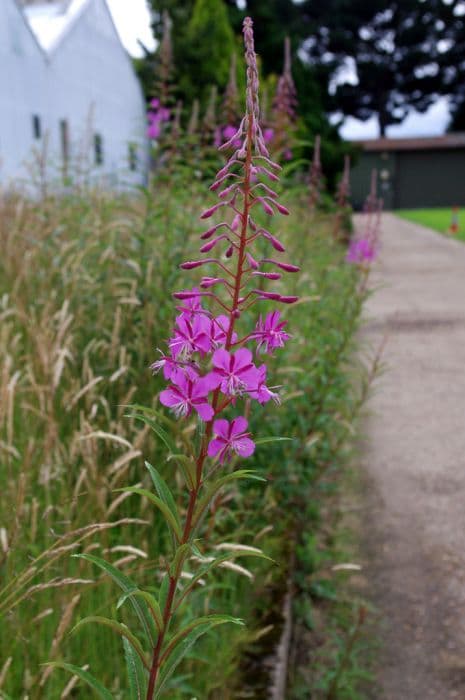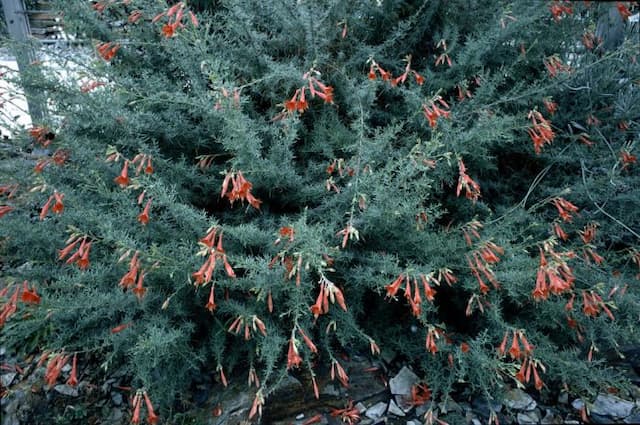Fuchsia Fuchsia 'Elma'

ABOUT
The Fuchsia 'Elma' is a visually striking plant, renowned for its beautiful, distinctive flowers that seem to add a touch of elegance wherever it grows. The flowers are a delightful combination of deep pink and vivid purple hues, a characteristic eye-catcher for this variety of fuchsia. They hang gracefully from the branches, displaying a pendulous growth habit that resembles dainty earrings. The petals are long, slender, and gently recurved, while the sepals — the outer part of the flower — flaunt a lighter pink, providing a lovely contrast to the richer toned petals. The foliage serves as a lush backdrop for the ornamental flowers, with leaves that are medium green in color and have a slight sheen. The leaves are oval to elliptical in shape with a softly serrated edge, which complements the overall delicate appearance of the Fuchsia 'Elma'. As a whole, the Fuchsia 'Elma' plant has a bushy and trailing structure, which makes it particularly well suited for hanging baskets and containers where its cascading flowers can be admired to full effect. Its appearance, with branches that flow and drape under the weight of the flowers, adds a romantic and whimsical feel to gardens and outdoor spaces. The display of these colorful, lantern-like blooms often continues throughout the growing season, attracting hummingbirds and other pollinators to the plant. Despite its delicate looks, it is a plant that draws attention and can become a focal point in any garden display.
About this plant
 Names
NamesFamily
Onagraceae.
Synonyms
Lady's Eardrops, Fairy Bells, Hummingbird Fuchsia.
Common names
Fuchsia 'Elma'.
 Toxicity
ToxicityTo humans
Fuchsia 'Elma', commonly known as Fuchsia, is not considered toxic to humans. However, ingestion of any plant material can cause gastrointestinal discomfort in sensitive individuals. If a large amount were ingested, symptoms might include nausea, vomiting, or diarrhea. It is always advisable to keep plants out of reach of young children who might accidentally ingest plant parts.
To pets
Fuchsia 'Elma', commonly known as Fuchsia, is also generally considered non-toxic to pets. Like humans, pets may experience mild digestive upset if they ingest parts of the Fuchsia plant, presenting as vomiting or diarrhea. Always monitor pets to prevent them from nibbling on household plants, and consult a veterinarian if any unusual symptoms occur after ingestion.
 Characteristics
CharacteristicsLife cycle
Perennials
Foliage type
Deciduous
Color of leaves
Green
Flower color
Mixed
Height
2 feet (0.61 meters)
Spread
2 feet (0.61 meters)
Plant type
Shrub
Hardiness zones
9
Native area
Central America
Benefits
 General Benefits
General Benefits- Vibrant Blossoms: Fuchsia 'Elma' produces beautiful, pendulous flowers that add a vibrant splash of color to any garden.
- Attracts Pollinators: Its flowers are known to attract hummingbirds and butterflies, which can help pollinate other plants in the garden.
- Shade Tolerance: This plant can thrive in partial shade, making it ideal for garden spots that don't receive full sunlight.
- Long Blooming Season: It has a long flowering period that often extends from spring to fall, providing extended visual interest.
- Versatility: Fuchsia 'Elma' can be grown in containers, hanging baskets, or in the ground, offering flexibility in garden design.
- Easy Pruning: The plant responds well to pruning, allowing gardeners to easily shape and manage its growth.
 Medical Properties
Medical Properties- This plant is not used for medical purposes.
 Air-purifying Qualities
Air-purifying QualitiesThis plant is not specifically known for air purifying qualities.
 Other Uses
Other Uses- Fuchsia 'Elma' can be used as a natural dye for fabrics, offering a unique color derived from its bright blossoms.
- In some cultures, the blossoms of the fuchsia are used to decorate dishes, adding an exotic touch to culinary presentations.
- Creative arts sometimes employ fuchsia blooms for botanical prints, using the natural shape and color of the flower in various art projects.
- Fuchsia flowers can be used to create scented sachets for closets or drawers, providing a subtle fragrance to stored clothing.
- The petals can be crystallized and used as edible decorations for cakes and desserts for a touch of elegance.
- These plants can act as inspiration for color palettes in interior design, providing a vibrant contrast in modern decor.
- Fuchsia flowers may serve as supplementary materials for handmade paper, contributing to its texture and visual appeal.
- During festive seasons, fuchsia branches can be incorporated into wreaths or garlands for natural home decor.
- The plant’s unique form and coloration can be a muse for fashion designers, influencing the design of prints and patterns in textiles.
- Fuchsia 'Elma' can be used to enhance the visual aesthetics of ponds or water features, floating the blooms on the surface for decorative purposes.
Interesting Facts
 Feng Shui
Feng ShuiThe fuchsia is not used in Feng Shui practice.
 Zodiac Sign Compitability
Zodiac Sign CompitabilityThe fuchsia is not used in astrology practice.
 Plant Symbolism
Plant Symbolism- Confiding Love: The Fuchsia flower has a unique hanging shape, resembling lanterns or droplets, which in the language of flowers is often associated with trust and confiding love, symbolizing the deep emotional connection one is willing to share and impart with another.
- Elegance and Grace: With its delicate petals and striking color combination, Fuchsias are often seen as symbols of elegance and grace, fitting for an ornamental plant that adds a touch of class and refinement to gardens and living spaces.
- Good Taste: The sophistication of the Fuchsia plant, in both appearance and in the taste of its berries, can suggest a sense of good judgment, often in matters of aesthetics and artistry.
- Amiability: The charming appearance of the Fuchsia, along with its welcoming hanging blossoms, can represent amiability and a warm, approachable character.
 Water
WaterFuchsia 'Elma', commonly known as Hardy Fuchsia, requires consistent moisture, so water it thoroughly when the top inch of soil feels dry to the touch, which might be approximately once or twice a week, depending on climate conditions. In hot, dry weather, increased frequency may be necessary. Provide around one to two gallons of water per watering session to ensure the root zone is adequately moistened. During winter, reduce the frequency to match the plant's slower growth rate and only water when soil is dry to avoid waterlogging.
 Light
LightHardy Fuchsia thrives in partial shade to full shade conditions. The best spot for this plant would be in a location that receives morning sunlight with protection from the intense afternoon sun, or in dappled shade beneath taller shrubs or trees. Avoid placing it in full sun, as this can lead to scorching of the delicate leaves and flowers.
 Temperature
TemperatureHardy Fuchsia prefers a moderate temperature range, thriving best between 55°F and 75°F. It can survive minimum temperatures down to around 40°F, but frost can severely damage or kill the plant, so provide protection during colder months. During hot summers, ensure the plant is in a cooler, shaded area to prevent heat stress.
 Pruning
PruningHardy Fuchsia benefits from pruning to encourage bushier growth and more blooms. Prune in late winter or early spring before new growth starts, cutting back the previous year's growth by about a quarter to a third. Remove any dead or damaged branches at this time as well. Pruning can also be done after the first flush of flowers to promote a second blooming period.
 Cleaning
CleaningAs needed
 Soil
SoilFuchsia 'Elma' prefers a well-draining soil mix with peat moss, perlite, and loam in equal parts, maintaining a slightly acidic pH of about 6.0 to 7.0 for optimal growth.
 Repotting
RepottingFuchsia 'Elma' typically needs to be repotted every 2 to 3 years, or when it becomes root-bound in its current container.
 Humidity & Misting
Humidity & MistingFuchsia 'Elma' thrives best in high humidity conditions, ideally around 60-70% relative humidity for optimal growth.
 Suitable locations
Suitable locationsIndoor
Provide bright, indirect light, and maintain high humidity.
Outdoor
Plant in dappled shade, protect from frost, and shelter from strong winds.
Hardiness zone
10-11 USDA
 Life cycle
Life cycleThe life cycle of Fuchsia 'Elma', commonly known as Fuchsia or Lady's Eardrops, begins with seed germination, occurring in moist, warm soil conditions where the tiny seeds develop into small seedlings. Following germination, the seedlings enter a period of vegetative growth, characterized by the development of the signature fuchsia foliage and bushy growth habit. As the plant matures, it enters the flowering stage, producing distinctive, pendulous blooms that are often bicolored, with a combination of purple, pink, red, or white. After pollination, which is facilitated by hummingbirds or other pollinators attracted to the flowers, the plant produces small fruit that contains seeds, completing the reproductive cycle. In temperate climates, Fuchsia 'Elma' may enter a period of dormancy during the cold winter months, with reduced growth and dieback of upper growth, requiring pruning in spring to stimulate rejuvenation. With proper care, the plant can return to the vegetative growth stage in the following season, starting the cycle anew.
 Propogation
PropogationPropogation time
Spring-Early Summer
Propogation: The most popular method of propagating Fuchsia 'Elma', commonly known as hardy fuchsia, is through softwood cuttings. This is typically done in late spring or early summer when the plant's growth is most vibrant. To propagate, select a healthy, non-flowering shoot and cut a 3 to 4-inch (approximately 7.6 to 10.2 cm) section just below a leaf node. Remove the leaves from the lower half of the cutting, and for best results, dip the cut end into a rooting hormone powder or solution. The cutting should then be placed in a pot filled with a well-draining potting mix, ensuring at least one leaf node is buried where roots are expected to form. To maintain a humid environment, you can cover the pot with a plastic bag or place it in a mini greenhouse. Keep the soil consistently moist but not waterlogged, and in a few weeks, the cutting should develop roots and can eventually be transplanted.









